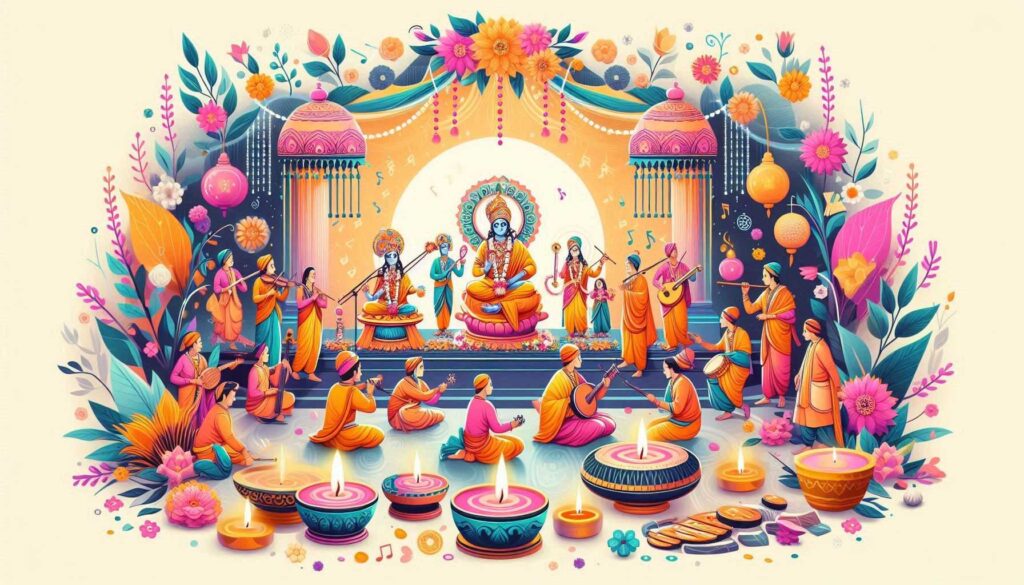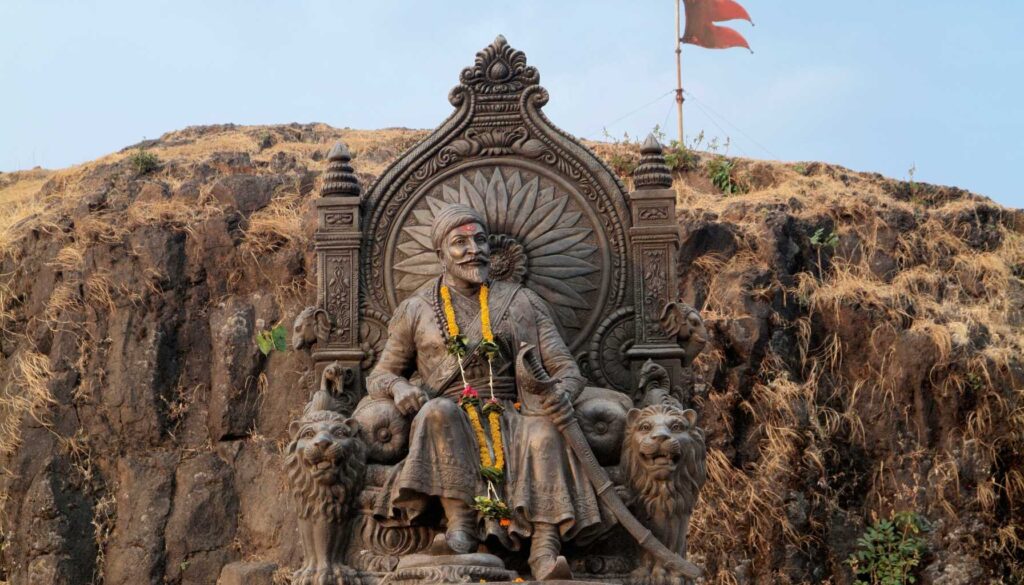March 2025 is a month brimming with festivities that hold profound spiritual and cultural meaning within the Hindu community. This month witnesses the celebration of vibrant festivals such as Holi, Ugadi, and Ramakrishna Jayanti, each carrying unique rituals, history, and relevance to the faith. Whether it’s the joyous splashing of colors during Holi or the solemn remembrance of Chhatrapati Shivaji Maharaj, March showcases the diverse and rich heritage of Hinduism.
1. Ramakrishna Jayanti (March 1, 2025)

Ramakrishna Jayanti marks the birth anniversary of Sri Ramakrishna Paramahamsa, one of the most revered saints in modern Hinduism. Celebrated on March 1, 2025, this day is dedicated to honoring the life and teachings of Ramakrishna, who emphasized the unity of all religions and the importance of personal devotion.
Read More About Hindu Philosophy
Rituals and Celebrations:
- Devotees gather in temples to offer prayers and participate in aarti.
- Special sermons and discourses on the life of Sri Ramakrishna are organized at spiritual centers such as the Ramakrishna Mission.
- The day is filled with devotional songs, bhajans, and readings from sacred texts.
Cultural Significance:
Ramakrishna Paramahamsa’s teachings emphasize universal spirituality, tolerance, and love for God, regardless of sect or religious background. This message resonates deeply with his followers, who celebrate his birthday as a day of spiritual reflection and communal unity.
2. Chhoti Holi and Holika Dahan (March 13, 2025)

Chhoti Holi, also known as Holika Dahan, is celebrated on the evening before the main Holi festival. It symbolizes the triumph of good over evil, based on the story of Prahlad and Holika from Hindu mythology. According to legend, Holika, the sister of the demon king Hiranyakashipu, tried to burn Prahlad in a fire, but Prahlad was saved by his unwavering faith in Lord Vishnu, while Holika perished.
Rituals and Celebrations:
- Large bonfires are lit, symbolizing the burning away of evil and the beginning of good fortune.
- Offerings such as coconuts, grains, and flowers are thrown into the fire as a part of the ritual.
- Communities come together to celebrate, sing songs, and share food.
Cultural Significance:
Holika Dahan represents the victory of righteousness over wickedness, reinforcing the message that faith in the divine will always protect the devout. It also sets the stage for the joyful festival of Holi that follows the next day.
3. Holi (March 14, 2025)

Holi, often referred to as the “Festival of Colors,” is celebrated with immense enthusiasm throughout India. This vibrant festival marks the arrival of spring, symbolizing the end of winter and the blossoming of love and joy. Holi is also linked to the playful love between Lord Krishna and Radha, especially in regions like Vrindavan and Mathura.
Rituals and Celebrations:
- People throw colored powders (gulal) and water at each other in a spirit of joy and togetherness.
- Traditional Holi foods like gujiya and thandai are prepared and shared among friends and family.
- Singing, dancing, and playing musical instruments are integral parts of the celebrations.
Cultural Significance:
Holi is not only a celebration of spring but also a time to mend relationships, forgive past grievances, and embrace unity. It fosters a sense of community, bringing people from all walks of life together in celebration.
4. Chaitanya Mahaprabhu Jayanti (March 14, 2025)

Chaitanya Mahaprabhu, born on Phalguna Purnima, is believed to be an incarnation of Lord Krishna. His teachings, which emphasized the importance of Bhakti (devotion) over ritualistic worship, inspired a significant spiritual movement that still resonates today.
Rituals and Celebrations:
- Devotees gather in temples to chant the Hare Krishna mantra and offer prayers.
- Processions with singing, dancing, and devotional music are organized in honor of Chaitanya Mahaprabhu.
- Scriptures such as the Chaitanya Charitamrita are read, highlighting his life and teachings.
Cultural Significance:
Chaitanya Mahaprabhu’s life represents the essence of devotional worship, transcending caste and societal boundaries. His message of love for Krishna through kirtans (devotional songs) continues to inspire the Krishna Consciousness movement, particularly ISKCON.
5. Chhatrapati Shivaji Maharaj Jayanti (March 17, 2025)

Chhatrapati Shivaji Maharaj Jayanti is celebrated on March 17, 2025, in honor of the birth of the legendary Maratha king Shivaji. His contributions to the revival of Hinduism and his role as a defender of Indian sovereignty make this day a significant one, especially in Maharashtra.
Rituals and Celebrations:
- Public processions, reenactments of Shivaji’s life, and cultural programs are organized.
- Statues of Shivaji are decorated with flowers, and people offer prayers.
- Schools and institutions hold special events to educate children about Shivaji’s legacy.
Cultural Significance:
Shivaji Maharaj is remembered not just as a warrior but as a visionary leader who promoted social justice, fairness, and religious tolerance. His birthday is a day of pride for Hindus, especially Marathas, as it commemorates his role in defending the faith.
6. Ugadi (March 30, 2025)

Ugadi marks the Hindu New Year for the people of Andhra Pradesh, Karnataka, and Telangana. Celebrated with great enthusiasm, it signifies the arrival of spring and new beginnings according to the lunisolar calendar.
Rituals and Celebrations:
- Houses are cleaned and decorated with rangolis and mango leaf torans.
- Special dishes like Ugadi Pachadi are prepared, symbolizing the different flavors of life (sweet, sour, bitter).
- Panchanga Shravanam, or the reading of the new almanac, is a key ritual performed by priests.
Cultural Significance:
Ugadi represents a fresh start, a day to forget the past and embrace new opportunities with hope and positivity. The festival teaches people to accept both the joys and challenges of life.
7. Gudi Padwa (March 30, 2025)

Gudi Padwa, celebrated mainly in Maharashtra, is the Marathi New Year and marks the beginning of the harvest season. It is considered an auspicious day to start new ventures and bring prosperity into the home.
Rituals and Celebrations:
- People hoist a Gudi (a flag adorned with silk cloth, flowers, and a copper vessel) outside their homes, symbolizing victory and prosperity.
- Homes are decorated with vibrant rangolis, and traditional dishes such as puran poli are prepared.
- Families gather for prayers and community events, celebrating the day with joy and hope.
Cultural Significance:
Gudi Padwa is a celebration of the triumph of good over evil and the welcoming of new beginnings. It is deeply connected to agricultural prosperity and the Marathi cultural ethos.
Conclusion
March 2025 is a month filled with festivals that represent the diversity and depth of Hindu culture and spirituality. From the vibrant colors of Holi to the reflective observance of Ramakrishna Jayanti, each festival carries profound meaning. These celebrations are not just a reflection of religious beliefs but also embody the core values of Hinduism: unity, devotion, and the triumph of good over evil.
As the cycle of seasons turns, these festivals remind Hindus to embrace life with joy, faith, and gratitude, continually renewing their connection to the divine and to each other.
Citations and Quotes:
- “Holi is the festival of colors, the festival of love and unity. It reminds us that life is meant to be celebrated in all its hues.” — Ancient Hindu Proverb
- “Sri Ramakrishna emphasized that all paths lead to the same truth, a teaching that continues to inspire people from all walks of life.” — Swami Vivekananda
- “Ugadi is not just the beginning of a new year


